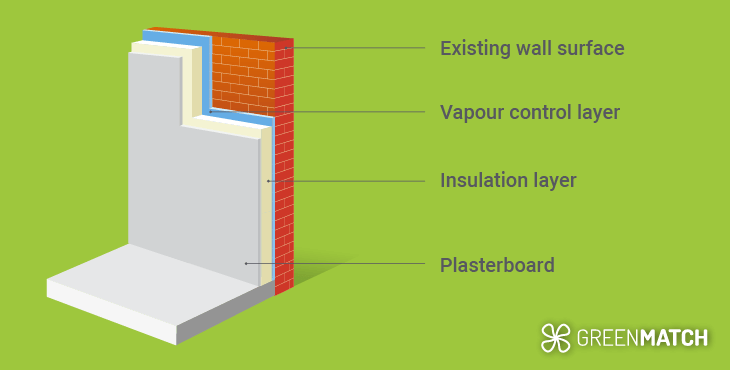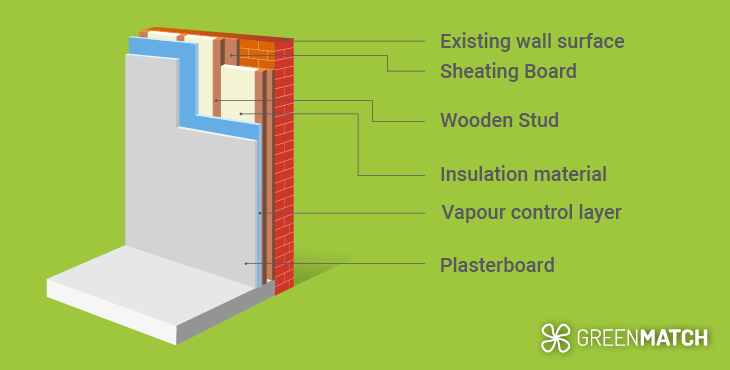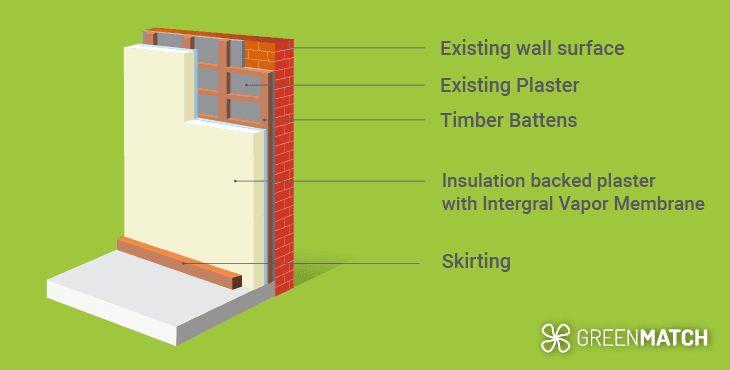Answer these simple questions and we will find you the BEST prices
Which type of solar quotes do you need?
It only takes 30 seconds
100% free with no obligation

Get Free quotes from insulation specialists near you

Save money by comparing quotes and choosing the most competitive offer

The service is 100% free and with no obligation
- GreenMatch
- Insulation
- Wall Insulation
- External Wall Insulation
- Single Brick Wall Insulation
How to Insulate a Single Brick Wall?


- 97% of UK single brick walls are uninsulated, causing up to 35% heat loss and higher energy bills.
- Internal or external brick insulation improves comfort, cuts energy bills by £700 yearly, and reduces carbon emissions by 2,100 kg.
- Single brick wall insulation costs range from £7,500 to £12,000, depending on whether you choose internal or external insulation methods.
Single brick walls are a common feature in older homes and outbuildings, but they often fall short when it comes to insulation, making it difficult to keep these spaces warm and energy-efficient. In the UK alone, about 30% of homes have single brick walls, and a staggering 97% of them remain uninsulated. This lack of insulation causes up to 35% of your home's heat to escape through the walls.
Single brick walls lack a thermal barrier, making them prone to heat loss, dampness, and drafts, unlike cavity walls. Proper insulation can boost comfort, lower energy bills by £700, and cut carbon emissions by 2,100 kg annually. Insulating these walls not only helps maintain a cosy living environment but also plays a vital role in achieving substantial energy and carbon savings.
This guide covers various methods to insulate single brick walls, including internal and external solutions, materials, and step-by-step instructions. Whether you're considering a DIY project or hiring an external wall insulation installer, this article will provide all the essential information to help you make the right choice for your insulation needs.
Ready to enhance your home's energy efficiency and comfort? GreenMatch is here to assist. We connect you with trusted professionals specialising in single brick wall insulation, providing the best solutions tailored to your needs. Fill out our quick 30-second form, and we'll match you with up to four free, no-obligation quotes from top-rated single brick insulation installers in your area. Click below to learn more.
- Describe your needs
- Get free quotes
- Choose the best offer
It only takes 30 seconds



Methods of insulating a single skin wall to meet building regs
The first step in insulating a single skin wall is choosing between internal or external wall insulation options. Both methods are effective and meet regulations; the best choice depends on your property type, budget, and preferences. To help you make an informed decision, here’s a quick overview of internal vs external wall insulation options:
Insulating a single brick wall from inside

Internal insulation is popular for single brick walls, improving thermal efficiency while preserving your home's original exterior appearance. Internal wall insulation involves adding a layer of insulation to the inner side of your walls, helping to reduce heat loss, minimise drafts, and create a warmer, more comfortable living space. There are four ways to insulate a single brick wall from the inside:
Stud wall insulation

Stud wall insulation adds a 100 mm thick secondary wall with a 40 mm cavity, reducing internal floor space slightly. Despite reducing space, it's ideal for uneven or ageing walls, allowing thicker insulation and offering excellent thermal performance. This method also creates space for integrating wiring and plumbing within the wall.
After building the stud wall, insulation is fitted snugly between the studs to prevent thermal bridging. A vapour barrier is applied to avoid condensation, and plasterboard panels are fixed over the framework using the dry lining technique, creating a smooth, finished surface. This method is more labour-intensive and costlier but is well-suited for older or damp-prone walls.
Direct wall insulation

Direct wall insulation is a straightforward method where insulation boards, typically rigid foam, are applied directly to the interior wall. The joints are sealed, a vapour barrier is added, and the wall is finished using dry lining with plasterboard. This approach, suitable for flat, damp-free walls, is cost-effective and less invasive.
It's a space-efficient solution that significantly improves energy efficiency. However, managing moisture and using specialised fixings to attach items like cabinets is essential. The combination of insulation and dry lining makes this method efficient and effective.
Batten wall insulation

Batten wall insulation involves attaching wooden or metal battens to the interior wall, creating a framework for placing insulation material. There are two types:
- Cold batten insulation: Battens are fixed directly to the wall, which can cause thermal bridging. The screws may also pierce the vapour barrier, reducing moisture resistance.
- Warm batten insulation: Insulation is applied directly to the wall, with battens placed on top, reducing thermal bridging and improving moisture resistance.
Once the insulation is installed, dry lining covers the battens with plasterboard, providing a neat finish. While batten insulation offers effective thermal performance, it takes up more room than other methods.
Insulating plaster application

Insulating plaster is a specialised material applied directly to walls, combining plastering with insulation. It's breathable, allowing moisture to pass through, making it suitable for older homes. This method adds minimal thickness, helps preserve floor space, and is one of the cheapest ways to insulate internal walls.
Though it improves thermal efficiency, insulating plaster typically offers less insulation than foam boards or batten insulation. It's often combined with dry lining in areas needing enhanced insulation or as a supplemental method in homes with less demanding insulation needs.
Insulating a single brick wall from outside

Insulating a single brick wall from the outside effectively improves thermal efficiency, protects against weather elements, and preserves internal space. The process involves adding insulation material to the exterior, followed by a protective finish. Here’s how to insulate a single brick wall from the outside:
- Wall preparation: Ensure the brickwork is in good condition and free from cracks, dampness, or damage. Clean the wall to remove dirt or loose paint, allowing the insulation to adhere properly.
- Install insulation boards: Fix insulation boards to the exterior using strong adhesive and mechanical fixings (screws and anchors). Arrange the boards to cover the entire surface without gaps to prevent heat loss. Seal joints with expanding foam or tape to maintain airtightness and prevent thermal bridging.
- Apply reinforcing mesh and base coat: Embed a fibreglass mesh into a cement or acrylic base coat to add strength, prevent cracking, and secure the insulation boards. This layer also serves as a weather-resistant barrier, preparing the surface for the final finish.
- Finish with render or cladding: Apply a topcoat of acrylic or silicone-based render for a smooth or textured finish, providing weather protection. Alternatively, cladding materials like timber, brick slips, or composite panels can be used for additional security and aesthetic variety.
While external wall insulation is more costly than internal options due to material and labour, it offers superior thermal efficiency by providing a continuous barrier around the house, making it ideal for single brick wall insulation.
Additional methods
Internal and external insulation are most effective for single skin walls, but additional, easier methods can also improve efficiency.
- Thermal lining paper: This thick, insulating wallpaper is a simple and quick way to improve insulation. Applied directly to interior walls, it helps reduce heat loss, making it an ideal DIY solution for those wanting a straightforward method. While it doesn't offer as much insulation as thicker options, it’s effective for smaller projects and doesn't require professional installation.
- Thermal curtains and blinds: These window treatments are made from thick, insulated fabrics that help retain heat during winter and block excess heat in summer. Easy to install, they offer year-round comfort and improved energy efficiency. While their insulating benefits are best when kept closed, they remain a practical solution for reducing heat loss, though they may limit natural light.
- Radiator reflective foil: Radiators mounted on external walls can lead to significant heat loss, especially in homes with uninsulated walls. Reflective foil is a thin, metallic sheet placed behind radiators to reflect heat back into the room, reducing heat loss through the wall. This method is easy to install and can be cut to fit any radiator size, making it a quick way to improve heating efficiency.
These smart methods provide effective solutions for insulating single-skin walls, boosting your home's thermal efficiency and reducing energy bills. But to ensure you find the perfect fit for your needs and budget, it's essential to consult with top insulation experts. That's where GreenMatch steps in! We'll connect you with the best solid wall insulation specialists, handpicked just for you. Fill out our quick 30-second form, and you'll receive up to four free quotes—no strings attached!
- Describe your needs
- Get free quotes
- Choose the best offer
It only takes 30 seconds



Single brick wall insulation building regulations

Understanding and complying with insulation building regulations is crucial for a safe and effective single brick insulation project. The key aspects to consider are moisture management and achieving the required U-value, which measures thermal efficiency.
- Insulation thickness: Aiming for an insulation thickness of 50mm to 100mm is advisable. This helps reduce heat loss while ensuring the insulation meets the required U-value standards without exceeding the maximum allowed.
- U-value requirements: According to building regulations, external insulation for single brick walls must achieve a U-value of 0.30 W/m2K or lower. Single brick walls, typically 225mm thick, have an existing U-value of around 1.20 W/2K. The chosen insulation material should be capable of reducing the U-value to meet this standard.
- Fire safety: The insulation material must comply with UK fire safety standards, ensuring it's fire-resistant and suitable for external wall insulation applications.
- Moisture control: Effective moisture management is crucial for single-brick insulation. Insulation should include a vapour barrier and proper ventilation to prevent dampness, mould growth, and potential structural damage.
- Structural integrity: Before installing external insulation, assess whether the existing structure can support the added weight without compromising stability. Reinforcements may be necessary to maintain the building's integrity.
- Oversail licence: If you opt for external wall insulation and your property is close to a public highway or pavement, and the external insulation will project over it, you must obtain an oversail licence to comply with local regulations.
Following these guidelines ensures your insulation project meets regulations, improves efficiency, and maintains your property's safety and integrity. While usually permitted, confirm with your local authority that your single brick insulation meets all planning requirements.
Single brick wall insulation cost

The cost of insulating a single brick wall can vary significantly depending on the method chosen, the size of the property, and the type of insulation material used. Here’s a breakdown of the main factors influencing the cost:
External single brick insulation
On average, installing external single brick insulation for a semi-detached home in the UK costs around £12,000. However, this price can vary based on the size of your property, the materials used, the need for scaffolding, waste removal, and any necessary wall repairs before insulation.
Below are the average material costs for external single brick insulation:
| Materials | Average cost per m2 |
|---|---|
| Insulation material | £10 to £21.50 per m2 |
| Adhesive and fixings | £7.50 per m2 |
| Reinforcing mesh | £3.50 per m2 |
| Render | £14 per m2 |
| Primer | £2 per m2 |
| Finishing materials | £4 per m2 |
If your home is two stories or more, scaffolding will be required, costing between £200 to £500 per week, including erection and dismantling. Additionally, if the insulation process generates substantial waste, hiring a skip might be necessary, with costs ranging from £125 to £320 per week, depending on the skip size.
It's also worth noting that planning permission can influence your costs. While external wall insulation typically falls under permitted development, you must apply for planning permission if your home is listed or located in a conservation area. This application comes with a flat fee of £548, which increases if the site exceeds 0.5 hectares.
Internal single brick insulation
The cost of single brick wall insulation in the UK generally ranges from £40 to £50 per square metre, with more intricate methods, such as stud wall insulation, reaching up to £100 per square metre. On average, insulating a semi-detached, three-bedroom house with single brick walls costs around £7,500. Since costs are calculated per square metre, larger surface areas will naturally increase the overall expense.
Before installing insulation, it's essential to address any existing issues, such as cracks, dampness, or structural problems, especially in single brick walls, as these repairs can significantly raise the total cost. Tackling moisture problems beforehand is crucial to prevent future complications, often adding to the project's expenses. Typically, minor repairs can add around £120 to the cost of a single brick wall insulation.
Labour accounts for approximately 60% of the total cost of both external and internal single brick insulation. Professional installers usually charge a daily rate, with more complex projects taking longer, resulting in higher labour expenses. On average, insulation specialists charge up to £250 per person daily.
By comparing multiple quotes from professional installers, you can find the best deals, gain insight into cost ranges, and secure the most competitive prices. While this process can be time-consuming and may not always yield results, GreenMatch makes it easy. Fill out our 30-second form, and we'll connect you with up to four free quotes from top insulation installers in your area—entirely free and with no obligation. Click below to learn more.
- Describe your needs
- Get free quotes
- Choose the best offer
It only takes 30 seconds



FAQ
Yes, you can insulate a single brick wall using either internal or external insulation methods to improve thermal efficiency.
To insulate a single-skin brick wall, you can install internal insulation boards or apply external insulation with a layer of insulating material covered by render or cladding.
To stop dampness on a single brick wall, apply a waterproof sealant, improve ventilation, and use breathable insulation materials.
To insulate brick walls from the inside, fix rigid insulation boards or apply insulated plasterboard directly to the interior wall. You can also create a stud or batten wall and fill it with insulation.
To dry line a single brick wall, attach plasterboard to the wall using adhesive or mechanical fixings, with or without insulation boards behind it, ensuring the surface is level, and joints are sealed for a smooth finish.

Caoimhe is an experienced content writer and researcher who is passionate about providing accessible information to every reader. With a background in English literature and Sociology, she combines the two disciplines to create cohesive, well-thought-out, and well-informed pieces.
We strive to connect our customers with the right product and supplier. Would you like to be part of GreenMatch?

